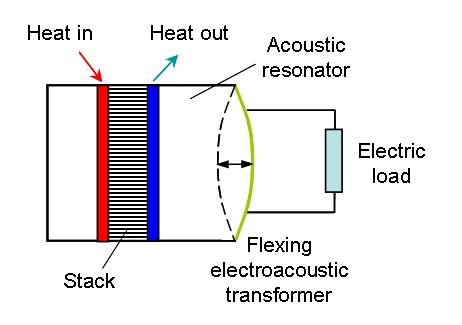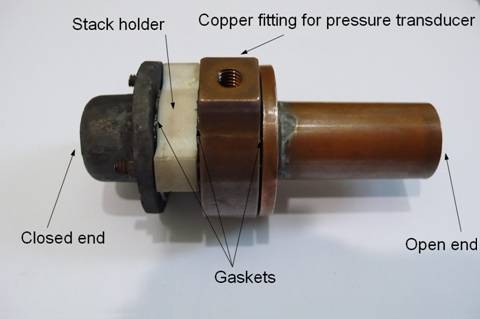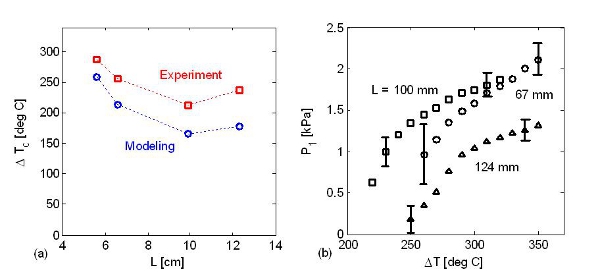Miniature
Thermoacoustic Engine
Konstantin I. Matveev - matveev@wsu.edu
Sungmin Jung
Popular version of paper 4pPA1
Presented Thursday afternoon, April 22, 2010
159th ASA Meeting,
Thermoacoustic engines convert heat into sound without moving parts. The generated acoustic power can be transformed into electricity with help of an electroacoustic transformer (Fig. 1) or used for cooling applications or gas mixture separation. We have built a robust miniature (few centimeters long) thermoacoustic engine demonstrator that can operate for hours without interruption (Fig. 2). Small-scale heat engines of this sort may eventually serve as reliable electric generators for sensors and MEMS when heat is available. The heat sources can include solar energy, waste heat, combustion of fuels, and radioactive isotopes. In remote unattended locations thermoacoustic engine-generators can be an attractive substitute for low-energy-density batteries.

Figure 1. Schematic of miniature thermoacoustic electric power source.

Figure 2. Small-scale experimental thermoacoustic engine.
Our thermoacoustic engine demonstrator (Fig. 2) is made of copper tube sections, ceramic holder, and a so-called stack (porous material inside the ceramic holder). We used reticulated vitreous carbon (RVC) as a stack medium. The tubes and holder form a cylindrical resonator. The atmospheric air serves as a working fluid. A temperature gradient was imposed in RVC by heating one side of the engine and cooling the other side. A complex physical analysis suggests that acoustic power will be produced inside a porous material at a large temperature gradient. In our simple but not optimized system the temperature difference required to generate sound was between 200 and 300 degrees Celsius (Fig. 3a). The energy-based theoretical model predicted a correct trend in this threshold but underestimated its actual values. Insufficient understanding of thermoacoustics of tortuous materials and simplifications in modeling are likely causes for this discrepancy. We tested our device with different resonator lengths (57-124 mm) and found the optimal length to be 100 mm for the selected RVC properties (80 pores-per-inch) and fixed dimensions of other system elements. The acoustic pressure amplitudes up to 160 dB were measured inside the engine (Fig. 3b). The estimated stack-based thermoacoustic energy conversion efficiency in this system is on order of a few percent, while the acoustic power generated in the stack may reach 0.1 Watt.

Figure 3. (a) Temperature difference at the sound onset. Squares, experimental values; circles, modeling results. (b) Acoustic pressure amplitudes recorded inside engines with different lengths.
Future research on miniature thermoacoustic engines can address optimization of various system parameters. For example, much more efficient (but more complicated) traveling-wave configurations can be built instead of simple standing-wave setups (as implemented in this study). Using noble gases or gas mixtures will also increase the engine efficiency. Raising the mean pressure will provide higher power density. Efficient and compact coupling of thermoacoustic engines with heat sources and electroacoustic transformers is needed for implementing practical electric power system packages based on this concept. A theoretical progress in understanding large-amplitude thermoacoustics, including tortuous stack environments, is also required. After addressing all these issues, researchers may hope to achieve about 10% overall thermal-to-electric energy conversion efficiencies with critical temperature differences of 10-100 degrees Celsius in the centimeter-scale thermoacoustic electric power sources.
Video with sound generated by a flame-driven thermoacoustic engine.
http://www.mme.wsu.edu/~matveev/
This material is
based upon work supported by the National Science Foundation under Grant No. 0853171.